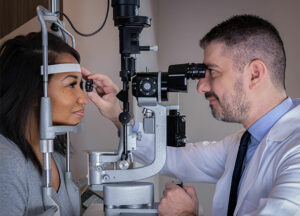Glaucoma Specialists
Schedule an Appointment Online
How Is Glaucoma Diagnosed?
Glaucoma is diagnosed through routine comprehensive dilated eye exams. As we have stated most cases of glaucoma are typically not suspected by patients. They are usually detected in the course of an eye examination or done for some other reason, such as “routine” exams, cataract evaluations, or even follow-ups of a patient with macular degeneration. It is much better to discover this before it becomes a problem.
The best defense against glaucoma is regular eye examinations by your ophthalmologist or optometrist. Early detection can mean the difference between normal and lost vision.
How Is Glaucoma Treated?
There are a variety of treatment options for glaucoma, including eye drops, oral medication, and surgery. Typically, medications are used to lower eye pressure. They do this by either improving the flow of fluid out of the eye or decreasing the amount of fluid the eye produces. For some patients, medication alone is not enough, and laser eye surgery is required. Surgery for glaucoma can be performed using either microsurgical instruments or a laser to improve the drainage of the eye, thus lowering the pressure inside the eye. While damage from glaucoma cannot be reversed, if it is caught early and treated properly, outcomes are usually very good.
Here at Wellish Abrams Vision Institute, we take an extensive approach to glaucoma doctor care, starting with a comprehensive eye examination including testing using our advanced glaucoma technologies. After our doctors determine if you do have one of the stages of glaucoma, we will discuss your treatment options with you. These treatment options can include eye drops, laser, and/or glaucoma surgery if deemed necessary.
The best way to figure out how to treat your glaucoma case is to see us for an in-office visit. We can then determine the progression of your disease and can begin with something as simple as a regimen of medical eye drops.
Get Help Today
The best way to figure out how to treat your glaucoma case is to see us for an in-office visit. We can then determine the progression of your disease and can begin with something as simple as a regimen of medical eye drops.
Our glaucoma specialists at Wellish Abrams Vision Institute are focused on patient well-being and the preservation of vision.

Get Help Today
If you are at risk for Glaucoma or symptoms of Glaucoma are making you uncomfortable and interfering with your daily life, call us. Our doctors across Nevada have the expertise and tools to give you the relief you need.
Locations
6710 S Fort Apache Rd
Las Vegas, NV 89148
2110 E Flamingo Rd, Suite 210
Las Vegas, NV 89119
10424 South Eastern Avenue, Suite 100
Henderson, NV 89052
2555 Box Canyon Dr.
Las Vegas, NV 89128
2555 Box Canyon Dr.
Las Vegas, NV 89128



